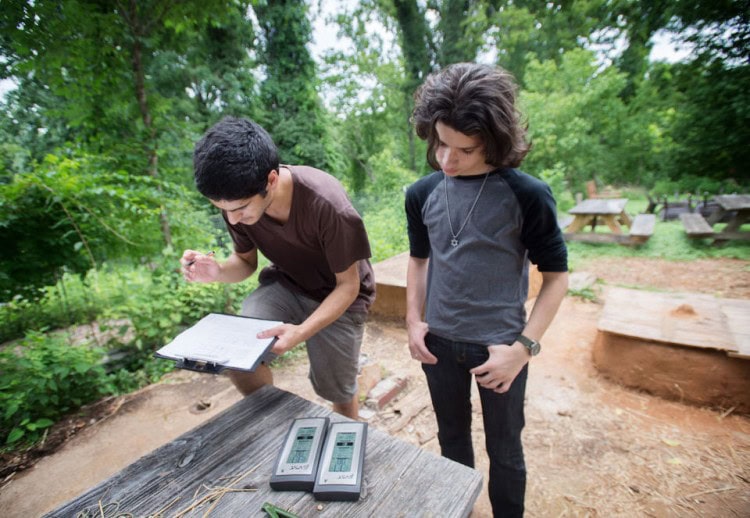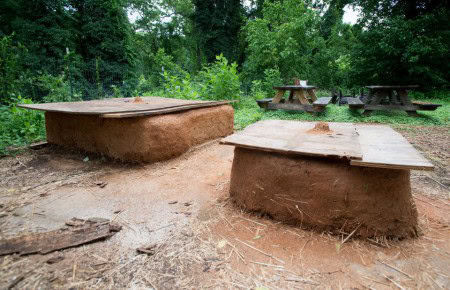A tiny house made of mud and straw might sound primitive, even prehistoric, but in a hidden garden on the far reaches of their campus, two Randolph College students are conducting modern experiments with these ancient building materials.
Their summer research project isn’t about nostalgia or historical curiosity. They think tiny houses made of mud and straw could play a useful role in today’s society in the United States, including here in Lynchburg.
“It makes it so other people who might not otherwise be able to own a house definitely could,” rising senior Sara Woodward said.
She and her research partner Hagay Haut will wrap up their participation in Randolph’s eight-week summer research program with a presentation of their findings and design ideas on Friday.
They’ve had help from Environmental Studies Professor Karin Warren, Randolph Sustainability Coordinator Ludovic Lemaitre, and Spencer Cohen, an E.C. Glass student with an interest in architecture.
Mud and straw, they said, are cheap and plentiful, and can produce sturdy structures. Construction takes time and work but it is possible to master without the years of training necessary for many other techniques. Small houses take less money and resources than bigger houses and can promote simpler living.
“If you are economically, environmentally minded then there are just a lot of benefits that make a lot of sense,” explained Haut.
He said modern houses based on these materials frequently have amenities such as electricity, plumbing and metal roofs.
Haut and Woodward’s research had two parts. Part one involved testing two building methods. Cob building mixes straw and subsoil, which around here is mostly clay. Straw-bale construction in this case meant bales of straw covered with chicken wire and then earthen plaster.
Soil is different from place to place, so the building project meant figuring out the best recipe for based on what’s available at Randolph.
The students built short structures out of each and then did regular readings for temperature and humidity. Both structures have plywood roofs sealed in with earthen plaster.
“We want to see more temperature fluctuation outside than inside,” Haut said. Both structures did well, proving their insulating properties. A home made from theses materials wouldn’t have as much of an energy load for heating and cooling, Warren pointed out.
Unfortunately, Haut said, the humidity inside has been a nearly constant 98 percent.
He said that’s not good, but also understandable because their houses are sealed with wet plaster. In a few weeks he said, the structures are likely to dry out further, so that should improve. Warren suggested they could test again in the fall.
The second part of their research involved thinking about the social implications and impacts of possibly building this kind of tiny house off campus. That meant looking at questions like what regulations could come into play and whether there could be an educational benefit to the wider community from such a project.
The regulations piece can be a big hurdle, the students said, because of a lack of regulatory framework for evaluating these buildings.
At one point in their research they talked with Mike McKinney, a Building Plans Reviewer for the City of Lynchburg.
“By meeting with Mike we also directly introduced straw bale construction to the City of Lynchburg,” the students wrote in their project blog.
“Not only are there no straw bale structures or codes set in place, but Mike and his colleagues were unfamiliar with the building method. After the meeting, Mike notified us that he had researched the method and that it is being considered for the 2015 edition of the Lynchburg adaptation of the IRC … It feels good to know that our research has an effect on the city!”
Right now Haut and Woodward aren’t personally expecting to build a functioning tiny house at Randolph, but they’ve laid the figurative groundwork that could be used for such a project later on.



